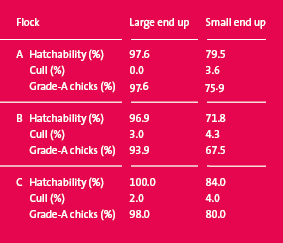



What Are The Effects Of Setting Eggs With Small Ends Up On Hatchability And Chick Performance
By Dr. Marleen Boerjan, Embryologist, Pas Reform - Eggs are incubated in setter trays for most of the incubation period. Three days before hatch, the eggs are transferred to hatcher baskets. In the setter trays the eggs are placed vertically with the air cell (large end) up, while the eggs lie horizontally during hatching.
Background
In normal development, the embryo begins to turn to its position along the long axis of the egg at day 14. At day 18, the beak is turned to the air cell and covered by the right wing. In this position the embryo can penetrate the inner cell membrane to gain access to the air in the air cell - after which breathing starts.
This normal sequence of events is disturbed when the eggs are placed with the air cell down and the small end up. In this scenario, the embryo still turns along the long axis of the egg with the head up - but now, the head is positioned in the small end of the egg - away from the air cell. The embryo may die because the initiation of normal lung breathing is hampered or even blocked.
Hatchability of eggs placed with small end up decreases from 12-30 per cent when compared to hatchability in eggs set large end up. However, once hatched from an egg set small end up, the performance of chicks is no different to that of chicks hatched from eggs placed large end up. In the table below, a summary of data collected from commercial hatcheries. Over 3,600 eggs were candled from each flock. The percentage of eggs placed small end up varied between 0.29-3.4 per cent, irrespective of the shape of the eggs.
Conclusions
 Reference: Bauer F., Tullet SG and Wilson HR (1990). Effects of setting eggs small end up on hatchability and post-hatching performance of broilers. |
The frequency of non-viable chicks from eggs set small end up increases, but varies between different batches of eggs. A hatchery loses 0.2 per cent of sellable chicks for each 1 per cent of fertile eggs placed with the small end up in a setter tray (Bauer et al, 1990).
Advice
Check each batch of eggs for the incidence of eggs placed small end up (upside down). Register the number of eggs palced upside down on Pas
Reform’s Hatchery Recording Form no. 2C (to receive your free copy of Pas Reform’s Hatchery Recording Forms, please complete and return the order form in the Library document Incubation Guide on www.pasreform.com).
If the frequency of eggs placed upside down is unsatisfactory - investigate and remedy the reasons for misplacement of the eggs.
If the eggs are routinely set in setter trays at the breeding farm, it is advisable to communicate the benefits (profit) of good placement and place responsibility for ensuring that eggs are place correctly with farm personnel. Breeder farm personnel should all be aware of the fact that the hatchery loses 0.2 per cent of sellable chicks for every 1 per cent of fertile eggs placed small end up in a setter tray.
Source: Pas Reform - June 2006








